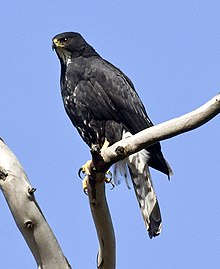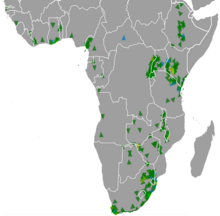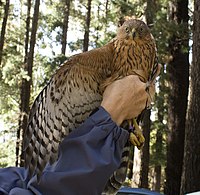
The common buzzard is a medium-to-large bird of prey which has a large range. It is a member of the genus Buteo in the family Accipitridae. The species lives in most of Europe and extends its breeding range across much of the Palearctic as far as northwestern China, far western Siberia and northwestern Mongolia. Over much of its range, it is a year-round resident. However, buzzards from the colder parts of the Northern Hemisphere as well as those that breed in the eastern part of their range typically migrate south for the northern winter, many journeying as far as South Africa.

The Accipitridae is one of the three families within the order Accipitriformes, and is a family of small to large birds of prey with strongly hooked bills and variable morphology based on diet. They feed on a range of prey items from insects to medium-sized mammals, with a number feeding on carrion and a few feeding on fruit. The Accipitridae have a cosmopolitan distribution, being found on all the world's continents and a number of oceanic island groups. Some species are migratory. The family contains 255 species which are divided into 70 genera.
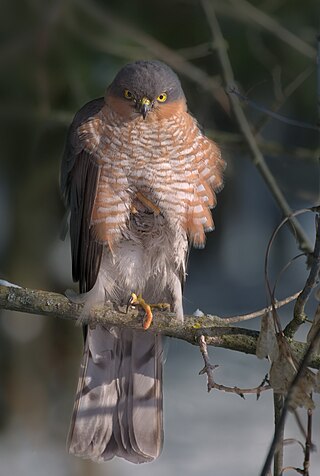
The Eurasian sparrowhawk, also known as the northern sparrowhawk or simply the sparrowhawk, is a small bird of prey in the family Accipitridae. Adult male Eurasian sparrowhawks have bluish grey upperparts and orange-barred underparts; females and juveniles are brown above with brown barring below. The female is up to 25% larger than the male – one of the greatest size differences between the sexes in any bird species. Though it is a predator which specialises in catching woodland birds, the Eurasian sparrowhawk can be found in any habitat and often hunts garden birds in towns and cities. Males tend to take smaller birds, including tits, finches, and sparrows; females catch primarily thrushes and starlings, but are capable of killing birds weighing 500 g (18 oz) or more.

The shikra is a small bird of prey in the family Accipitridae found widely distributed in Asia and Africa where it is also called the little banded goshawk. The African forms may represent a separate species but have usually been considered as subspecies of the shikra. The shikra is very similar in appearance to other sparrowhawk species including the Chinese goshawk and Eurasian sparrowhawk. They have a sharp two note call and have the typical flap and glide flight. Their calls are imitated by drongos and the common hawk-cuckoo resembles it in plumage.

The African hawk-eagle is a large bird of prey. Like all eagles, it belongs to the family Accipitridae. This species’ feathered legs mark it as a member of the Aquilinae subfamily. The African hawk-eagle breeds in tropical Sub-Saharan Africa. It is a bird of assorted woodland, including both savanna and hilly areas but the tend to occur in woodland that is typically dry. The species tends to be rare in areas where their preferred habitat type is absent. This species builds a stick nest of around 1 m (3.3 ft) across in a large tree. The clutch is generally one or two eggs. The African hawk-eagle is powerfully built and hunts small to medium sized mammals and birds predominantly, occasionally taking reptiles and other prey as well. The call is a shrill kluu-kluu-kluu. The African hawk-eagle is considered a fairly stable species and a species of Least Concern per the IUCN.

The lizard buzzard, or lizard hawk, is a bird of prey in the family Accipitridae. It is native to Sub-Saharan Africa. Despite its name, it may be more closely related to the Accipiter hawks than the Buteo buzzards.

The long-legged buzzard is a bird of prey found widely in several parts of Eurasia and in North Africa. This species ranges from Southeastern Europe down to East Africa to the northern part of the Indian subcontinent. The long-legged buzzard is a member of the genus Buteo, being one of the larger species therein. Despite being relatively powerful, it is considered a rather sluggish raptor overall. Like most buzzards, it prefers small mammals such as rodents, including gerbils, ground squirrels, voles and rats, also taking reptiles, birds and insects as well as carrion. Adaptable to a variety of habitats, long-legged buzzards may nest on a variety of surfaces, including rocks, cliffs and trees. it is a typical buzzard in its reproductive biology. The long-legged buzzard is widely distributed and appears to be quite stable in population. Therefore, it is considered as Least Concern by the IUCN.

The Levant sparrowhawk is a small bird of prey. It measures 32–38 cm (13–15 in) in length with a wingspan of 65–75 cm (26–30 in). The female is larger than the male, but the difference is not as marked as with Eurasian sparrowhawk. The adult male is blue-grey above, with dark wingtips, and barred reddish below.

Verreaux's eagle is a large, mostly African, bird of prey. It is also called the black eagle, especially in southern Africa, not to be confused with the black eagle of south and southeast Asia. The Verreaux's eagle lives in hilly and mountainous regions of southern and eastern Africa, and very locally in the Middle East.

The collared sparrowhawk is a small, slim bird of prey in the family Accipitridae found in Australia, New Guinea and nearby smaller islands. As its name implies the collared sparrowhawk is a specialist in hunting small birds. It is characterised by its slight brow ridges and slender feet. The last segment of their middle toe projects beyond the claws of the other toes.

The pale chanting goshawk is a bird of prey in the family Accipitridae. This hawk breeds in southern Africa and is a resident species of dry, open semi-desert with 75 cm or less annual rainfall. It is commonly seen perched on roadside telephone poles.

The augur buzzard is a fairly large African bird of prey. This species is distinct in typical adult plumage for its blackish back, whitish underside and orange-red tail, while juvenile augur buzzards are generally rather brown in colour; however a dark morph is known, which causes the bird's entire body to become darker. This member of the Buteo genus is distributed in several parts of the central and southern Africa, normally being found from Ethiopia to southern Angola and central Namibia. It is resident and non-migratory throughout its range. This is a species of mountains, and adjacent savannah and grassland. This is a typical buteonine raptor, being a generalist predator which tends to prefer small mammals supplemented by reptiles and birds among various prey items.

The tiny hawk is a small diurnal bird of prey found in or near forests, primarily humid, throughout much of the Neotropics. It is primarily a bird-eater, and is known to prey on hummingbirds.

The bicolored hawk is a species of bird of prey in the family Accipitridae. It is found in forest, woodland, second growth, plantations, and wooded savanna in southeastern Mexico, Central America, and northern and central South America. Though generally uncommon, it is the most common species of Accipiter in most of its range, but it does not occur at altitudes above 2,700 metres (8,900 ft) such as the highest parts of the Andes.
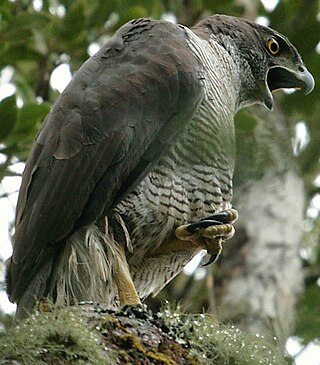
Henst's goshawk is a species of bird of prey in the family Accipitridae. It is a large, diurnal bird endemic to the island of Madagascar. It is an obligate forest species that occurs at very low densities on the island and is rarely seen. It can only occupy the primary and secondary forests found within the island. Its natural habitats are subtropical or tropical dry forest, subtropical or tropical moist lowland forest, subtropical or tropical moist montane forest, and plantations.

The little sparrowhawk is a species of Afrotropical bird of prey in the family Accipitridae. It is the smallest member of the genus Accipiter and forms a superspecies with the red-thighed sparrowhawk.
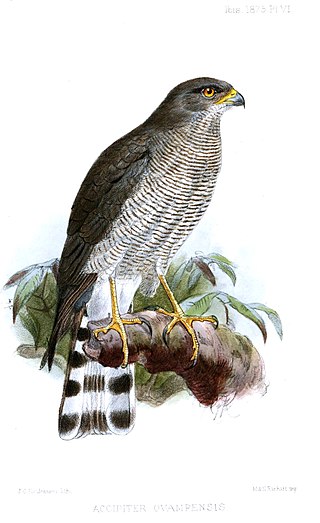
The Ovambo or Ovampo sparrowhawk, also known as Hilgert's sparrowhawk, is a species of sub-Saharan African bird of prey in the family Accipitridae. It takes its name from the Ovamboland in northern Namibia.

The rufous-breasted sparrowhawk, also known as the rufous-chested sparrowhawk and as the red-breasted sparrowhawk, is a species of bird of prey in the family Accipitridae. It is found in Angola, Democratic Republic of the Congo, Eritrea, Eswatini, Ethiopia, Kenya, Lesotho, Malawi, Mozambique, Rwanda, South Africa, South Sudan, Tanzania, Uganda, Zambia, and Zimbabwe.

The African goshawk is an African species of bird of prey in the genus Accipiter which is the type genus of the family Accipitridae.

The Eurasian goshawk is a species of medium-large bird of prey in the family Accipitridae, a family which also includes other extant diurnal raptors, such as eagles, buzzards and harriers. As a species in the genus Accipiter, the goshawk is often considered a "true hawk". The scientific name is Latin; Accipiter is "hawk", from accipere, "to grasp", and gentilis is "noble" or "gentle" because in the Middle Ages only the nobility were permitted to fly goshawks for falconry.

